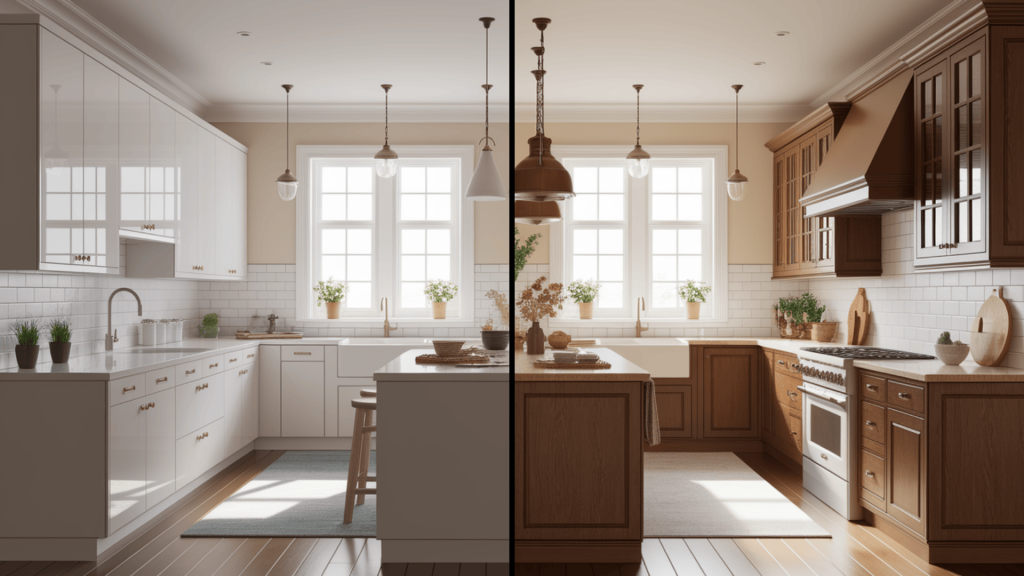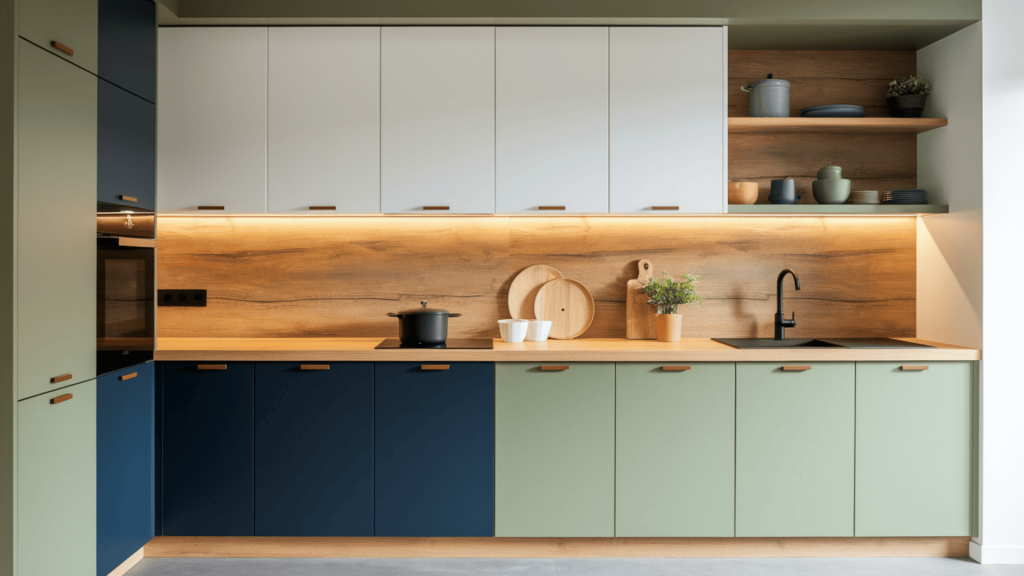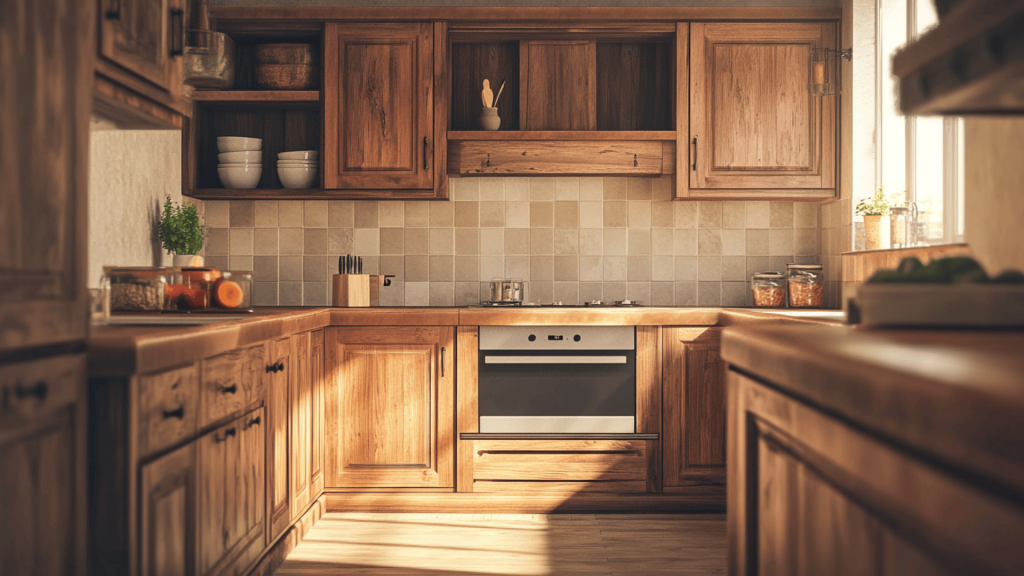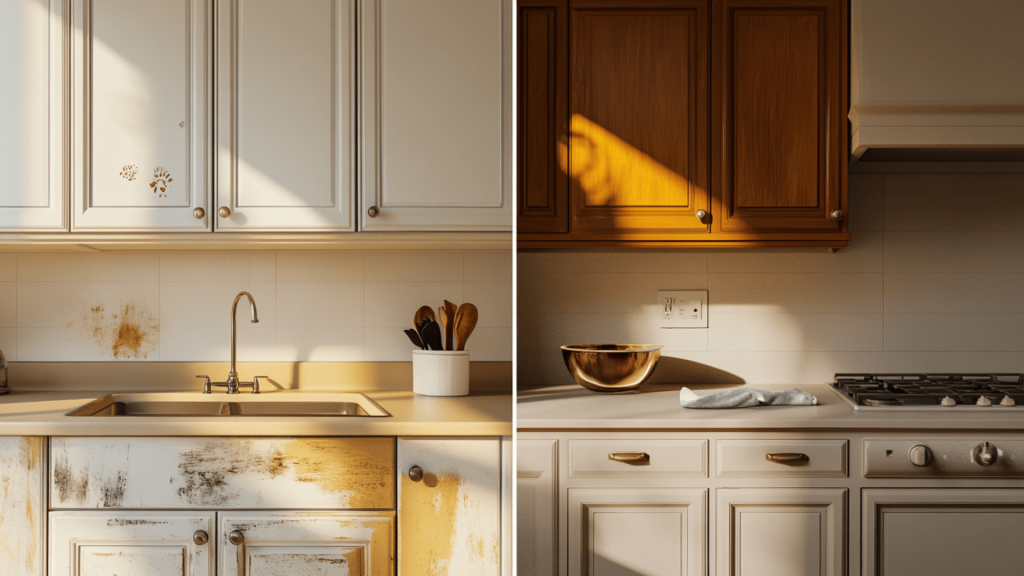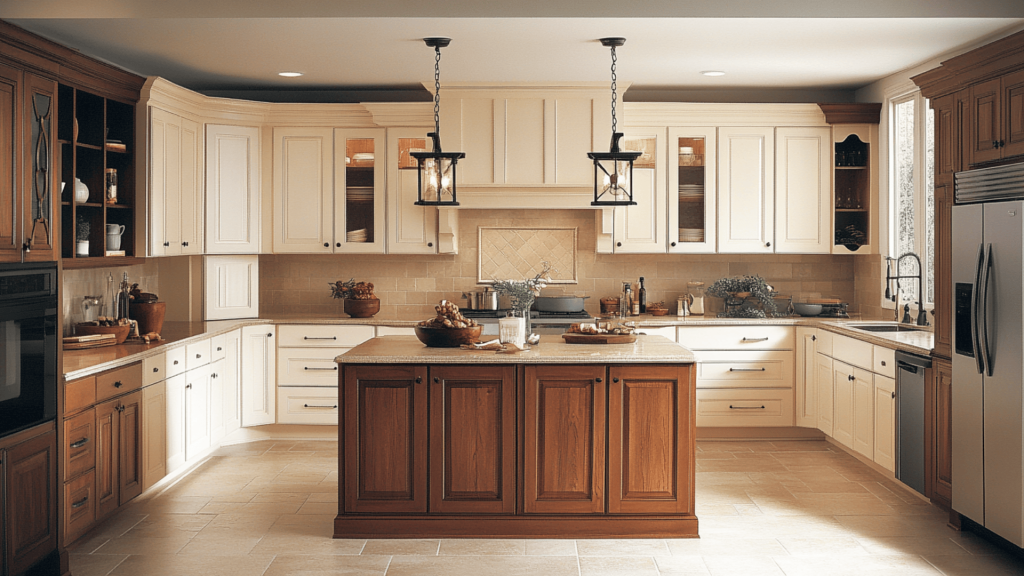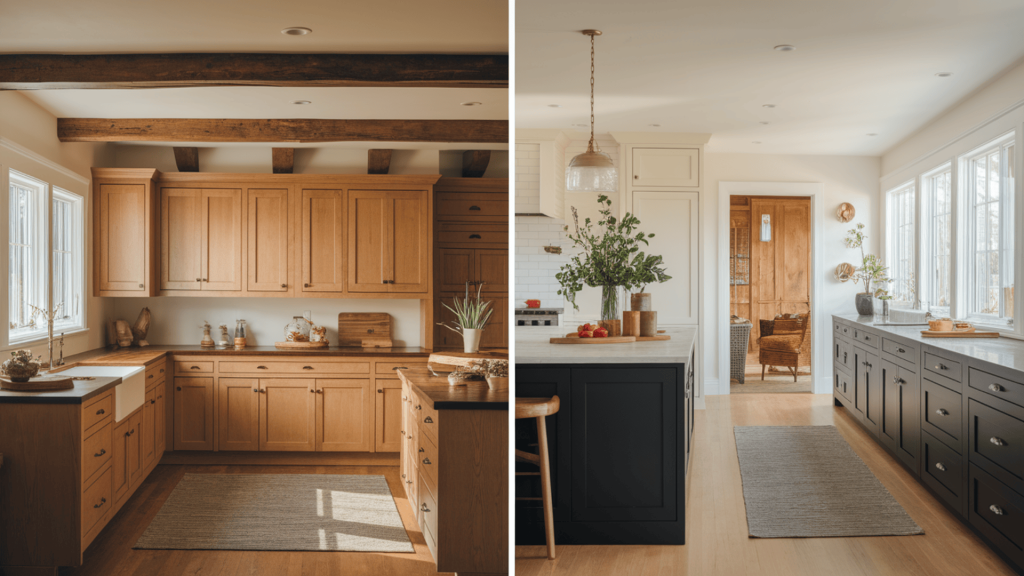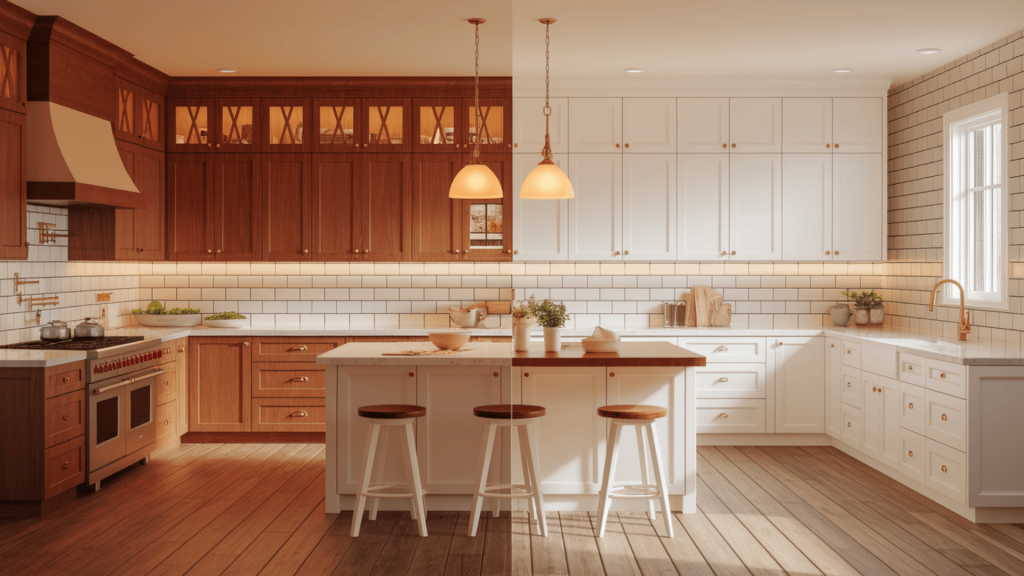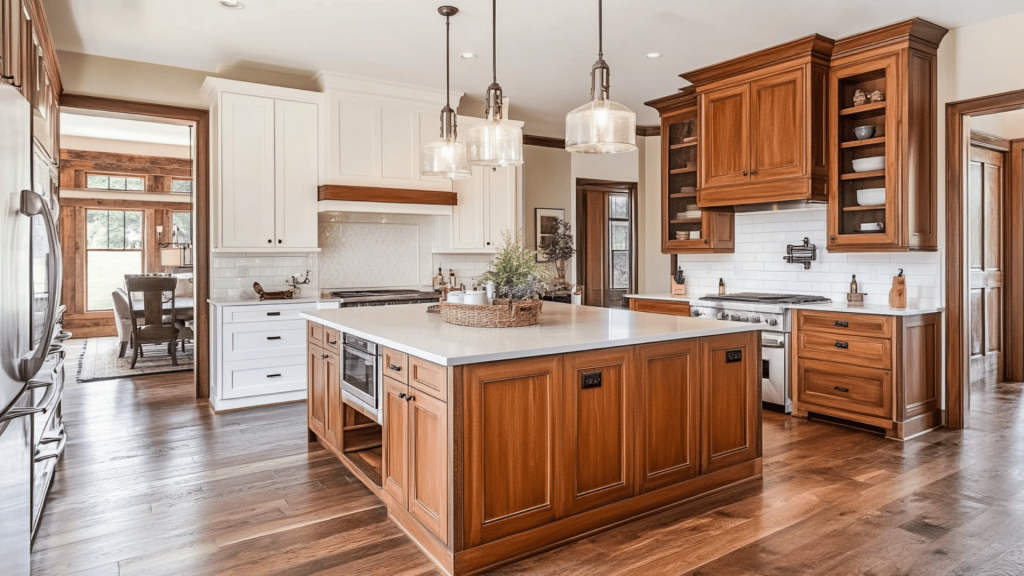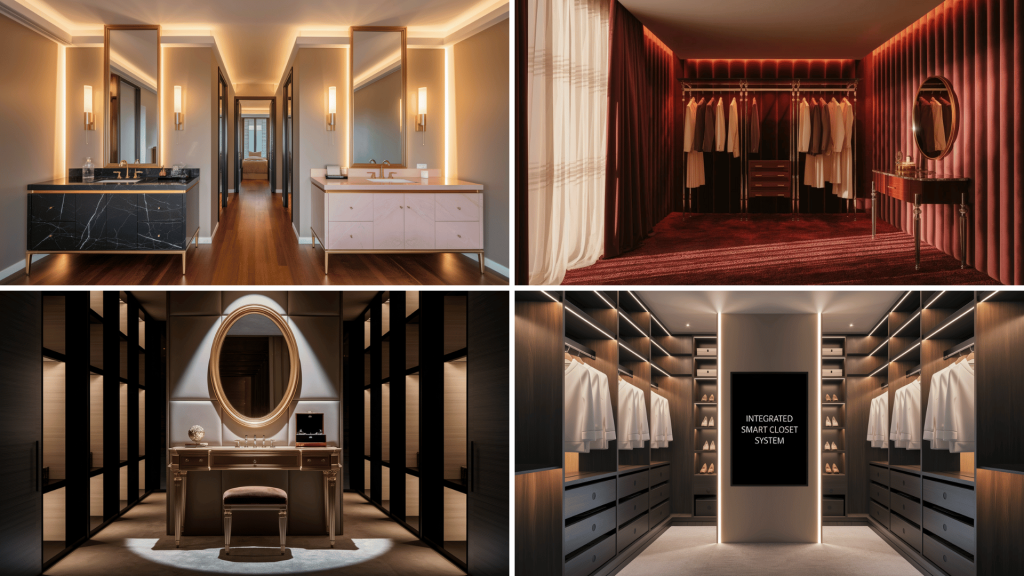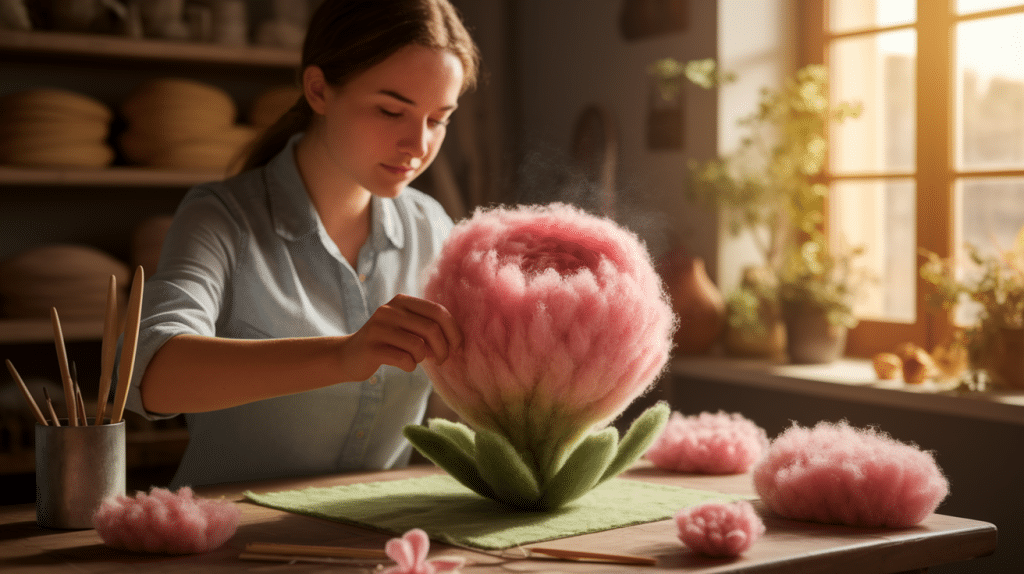Kitchen cabinets define your space’s personality.
The paint versus stain decision impacts not just looks, but also budget, upkeep, and long-term satisfaction.
Painted cabinets offer crisp lines and unlimited color choices, creating bright, modern kitchens.
Stained options showcase natural wood grain with rich depth, bringing warmth to traditional spaces.
Both choices have distinct benefits and drawbacks that affect cost, maintenance, and style.
Your cabinet finish choice ranks among the most important kitchen design decisions you’ll make – it sets the tone for your entire home.
Let’s compare these options to help you pick the perfect finish for your kitchen transformation.
Quick Verdict: Should You Choose Painted or Stained Cabinets?
Your cabinet choice shapes your kitchen’s look and feel.
Painted cabinets offer smooth, uniform surfaces with no wood patterns showing through.
You can choose nearly any color, making them perfect for modern homes.
Stained cabinets highlight natural wood grain with warm, earthy tones.
They’re more budget-friendly and better hide minor damage.
They suit traditional and rustic homes well.
| FEATURE | PAINTED CABINETS | STAINED CABINETS |
|---|---|---|
| Look | Smooth, Uniform | Natural Wood Grain |
| Color Range | Unlimited | Wood Tones Only |
| Cost | Higher | Lower |
| Damage Visibility | Shows Chips Clearly | Conceals Minor Marks |
| Cleaning | Shows Dust | Hides Dust Better |
| Best For | Modern Spaces | Traditional Homes |
The right choice depends on your personal taste, budget, and kitchen use.
Paint works best if you want bright colors and clean lines.
Staining makes sense if you love natural wood looks and want to save money.
Pros and Cons of Painted Cabinets
Paint gives cabinets a smooth, clean finish that many homeowners love.
The finish hides knots and grain, creating a consistent look throughout your kitchen.
Here are the main benefits you’ll enjoy with painted cabinets:
- Offers unlimited color options from white to black
- Hides wood flaws and imperfections effectively
- Works well with budget materials like MDF
- Makes small kitchens appear larger and brighter
Despite these advantages, painted cabinets do come with some drawbacks to consider for your kitchen project:
- Shows chips and damage more noticeably
- Difficult to touch up small areas without repainting whole sections
- Costs 15-25% more than stained finishes
- Requires more frequent maintenance (every 5-7 years)
These factors make painted cabinets ideal for homeowners seeking a crisp, modern look who don’t mind some extra maintenance to keep their kitchen looking fresh.
Pros and Cons of Stained Cabinets
Stain shows off wood’s natural beauty and character.
Each cabinet tells its own story through grain patterns, making your kitchen truly one-of-a-kind.
The key advantages of choosing stained cabinets include:
- Touch-ups blend easily with the existing finish
- More affordable both initially and long-term
- Stands up better to daily wear and tear
- Hides dust, fingerprints, and minor scratches well
While beautiful, stained cabinets aren’t perfect for every situation.
Consider these potential downsides:
- Limited color range (mostly brown and amber tones)
- Shows wood flaws and knots prominently
- Not suitable for lower-quality wood or MDF
- Requires quality hardwood for best results
For many homeowners, the warmth and character of stained cabinets make them worth these limitations, especially in homes with traditional styling or where natural materials are featured.
Cost Comparison: What’s Cheaper in the Long Run?
The upfront cost difference can be significant.
Painted cabinets typically cost 15-25% more than stained ones due to extra labor and materials.
A medium-sized kitchen might see $1,000-2,000 in extra costs for paint.
Over time, stained cabinets often prove more economical.
Their ability to hide minor damage means less frequent repairs and touch-ups.
When you do need fixes, they blend better with the existing finish.
| COST FACTOR | PAINTED CABINETS | STAINED CABINETS |
|---|---|---|
| Initial Cost (10×10 Kitchen) | $4,500-$7,800 | $3,800-$6,200 |
| Professional Installation | $2,000-$3,500 | $1,500-$2,500 |
| Touch-up Kit | $75-$150 | $40-$80 |
| Full Refinishing | $2,500-$4,000 Every 5-7 Years | $1,800-$3,000 Every 7-10 Years |
| 10-Year Total Cost | $7,000-$15,300 | $5,300-$11,700 |
Your cabinet material greatly impacts which finish makes financial sense.
For solid wood cabinets, staining offers better value.
With MDF or plywood, painting makes more sense despite higher initial costs.
Durability, Maintenance, and Lifespan: Which Lasts Longer?
Stained cabinets generally win the durability contest.
The finish penetrates the wood rather than sitting on top, making it less prone to chipping or peeling.
Daily cleaning stays similar for both types – a damp cloth works well.
Stained cabinets hide dust and minor marks better, making them more forgiving in busy households.
1. Daily Wear and Kitchen Activity
When minor damage happens, stained cabinets have a clear advantage.
Touch-ups blend naturally with the wood grain, while painted cabinets often need whole sections redone to look right.
Heat and sunlight affect both finishes but in different ways.
Paint may yellow over time, while stain might fade.
Kitchens with lots of natural light should consider this factor.
Cabinets near sinks or stoves face more stress from moisture and heat.
Stained finishes typically hold up better to these conditions without showing water spots or heat damage.
2. Cleaning and Care Requirements
Both finishes need regular cleaning, but they show dirt differently.
White painted cabinets show every smudge and fingerprint, requiring more frequent wiping.
Cleaning products matter, too.
Harsh chemicals can damage paint finishes faster than stained ones.
Most experts recommend mild soap and water for both types.
Grease buildup occurs in every kitchen, especially near cooking areas.
Stained cabinets often better mask this buildup, while painted surfaces—especially light colors—show it clearly.
3. Long-Term Maintenance Planning
Long-term, expect to refinish painted cabinets every 5-7 years with normal use. Stained cabinets can often go 7-10 years before needing attention.
Homes with young children or pets might find stained cabinets more practical.
They hide the signs of daily life better and repair more easily when accidents happen.
For both types, proper care extends lifespan.
Using cabinet hardware rather than touching doors directly, wiping spills promptly, and avoiding steam damage all help maintain your finish longer.
Aesthetic Impact: How Each Finish Affects Your Kitchen’s Vibe
Paint creates clean, crisp lines that work beautifully in modern spaces.
White cabinets make small kitchens feel larger and brighter, while bold colors can turn cabinets into statement pieces.
Stain brings warmth and depth that paint can’t match.
The wood grain creates visual texture and natural variation that many find homey and welcoming.
Creating Contrast and Balance
Mixing both finishes has become popular, like painting upper cabinets white while staining lower ones in rich brown.
This gives the best of both worlds: brightness up top and warmth below.
Kitchen islands offer another mixing opportunity.
A stained island can warm up an otherwise painted kitchen, creating a focal point that feels grounded.
Working with Light and Space
Your kitchen’s light matters, too.
North-facing rooms might benefit from the warmth of stain, while already-bright south-facing kitchens could handle darker paint colors.
Consider your home’s overall style when choosing.
Craftsman or farmhouse styles pair naturally with stain, while sleek modern homes often look better with paint.
Practical Tips for Choosing the Right Finish for Your Home
Selecting between paint and stain goes beyond just looks.
Your choice affects how your kitchen functions day-to-day and how it will age over time.
Consider these practical factors before making your final decision.
Think about your daily habits.
Households that cook often might prefer stain’s forgiving nature, while those seeking a pristine look might choose paint despite the upkeep.
Consider your main priorities with these key points:
- Match the cabinet finish to your existing elements (flooring, countertops, backsplash)
- Factor in your family lifestyle – kids, pets, and cooking habits affect durability needs
- Choose hardware that complements your finish – warm metals for stain, modern finishes for paint
- Consider your cleaning preferences – darker stains hide marks better than light paint
- Think long-term about maintenance comfort – are you willing to refinish more often?
Most importantly, pick what you love.
Cabinets last many years, so choose a finish that makes you happy each time you walk into your kitchen.
Still Undecided? Mixing Both Finishes Might Be Your Best Move
Can’t choose between painted and stained cabinets?
You don’t have to.
Many homeowners now mix both finishes in the same kitchen, getting the best of both worlds while creating visual interest.
Mixing cabinet finishes has become increasingly popular in kitchen design.
This approach lets you highlight certain areas while maintaining unity throughout the space.
Creating a Balanced Mixed-Finish Kitchen
The most common ways to combine these finishes include:
- Painted upper cabinets with stained lower cabinets
- Stained island with painted perimeter cabinets
- Maintain unity with matching cabinet styles and hardware
- Use the darker finish on lower cabinets for grounding
- Ensure one finish remains dominant (70/30 ratio works well)
Many designers recommend staining heavily used areas (around sinks, lower cabinets) and painting areas that need brightness or bold color (upper cabinets, display areas).
This strategy offers practical benefits, too.
You’ll gain stain’s durability where it matters most while enjoying paint’s design flexibility in less-used areas.
Wrapping It Up
Making the final call between painted and stained cabinets comes down to your priorities.
Paint offers color freedom with higher maintenance, while stain showcases natural wood with greater durability. Many homeowners now mix both for the perfect balance.
Consider your home’s style, kitchen use, and long-term plans before deciding.
Take time with samples in your actual space—your perfect kitchen awaits with either finish or a thoughtful combination of both.
Your kitchen should tell your story—whether it’s written in bold paint or whispered through natural wood grain.
Comment below with your cabinet choices and why you choose you choose paint, stain, or both?
We’d love to hear about your beautiful makeover!

